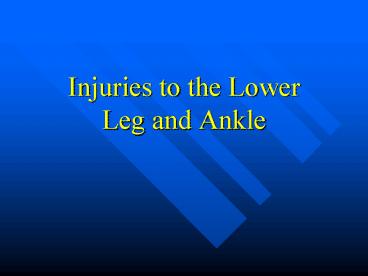Injuries to the Lower Leg and Ankle PowerPoint PPT Presentation
1 / 39
Title: Injuries to the Lower Leg and Ankle
1
Injuries to the Lower Leg and Ankle
2
Lower Leg Injuries
- Caution! Graphic Picture
3
4
Contusions
- Shin contusion
- - little soft tissue to absorb force
- - Periosteum receives impact
- - MOI Direct blow
5
6
Compartment Syndrome
- Increased pressure in compartments compromises
muscles, nerves, or blood vessels - 4 compartments in lower leg
- Caused by overuse or direct contact
- Athlete has pain, decreased sensation over foot,
possible foot drop
7
8
Fasciotomy
9
Muscle Strain
- Calf is most affected (usually at
gastroc-achilles junction) - MOI violent contraction
- excessive dorsiflexion
- overuse
10
Achilles Tendonitis
- Inflammation of the Achilles
- MOI overuse, microtearing of tendon
- Signs pain, point tender, crepitus, swelling
11
Achilles Tendon Tear
12
13
Muscle Spasm
- Calf usually affected
- MOI fatigue, dehydration
- Treatment direct compression, gradual stretch,
ice, rehydrate
14
Leg Fractures
- Direct blows or indirect trauma
- Fibular fracture more common
- Deformity, pain, unable to bear weight (Fibula?)
15
(No Transcript)
16
17
18
Stress Fractures
- An incomplete break in a bone occurring after
prolonged repetitive exercise
19
Stress Fractures (cont)
- Signs and Symptoms
- - intense pain
- - point tender
- - more painful after activity
- - percussion test
20
21
Medial Tibial Stress Syndrome
- shinsplints
- Pain along medial border of the tibia
- Usually with novice runners well conditioned
runners usually due to mechanical abnormalities
22
- Causes - running on hard
- surfaces
- - Overuse
- - Muscle imbalance
- - Tight Achilles
23
24
Ankle Injuries
25
Mechanisms of Injuries
- Inversion
- - bony stability is greater medially than
laterally - - fibula extends more distally than tibia
prevents eversion - - occur from running on uneven surfaces or
cutting
26
- Plantar Flexion
- - Usually sprain ankle when in plantar flexion.
- - Ankle is unstable in this position
27
- Eversion
- - usually due to a planted foot that receives a
lateral force - - stepping in a hole
- - higher incidence of fractures
28
Lateral Ligament Sprain
- Most common ankle injury
- MOI Inversion and plantar flexion
29
- Anterior Talofibular Ligament (ATF) is injured
first. (mild sprain) - The Calcaneofibular Ligament (CF) is injured in
more severe sprains - The Posterior Talofibular Ligament is injured in
the most severe sprains
30
INVERSION ANKLE SPRAIN
31
Ankle inversion
32
Medial Ligament Sprain(Deltoid Ligament)
- Often associated
- with fractures
- of
- lateral malleolus
33
- Often associated
- with a blow to
- lateral side of body
34
- Eversion Sprain
35
The Deltoid Ligament
36
Peroneal Tendon Injury
- Attach Peroneus longus muscle of the Lateral
compartment to foot - Eversion of foot and ankle
37
- Can occur when lateral ankle ligaments are
injured - Common problems are dislocation of tendons over
lateral malleolus - or peroneal tendonitis
38
Surgical Repair of Peroneal Tendons
39
(No Transcript)

